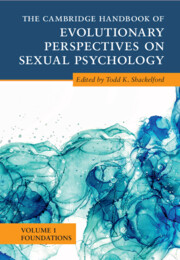Book contents
- The Cambridge Handbook of Evolutionary Perspectives on Sexual Psychology
- The Cambridge Handbook of Evolutionary Perspectives on Sexual Psychology
- Copyright page
- Contents
- Contributors
- Preface
- Part I Foundations of Evolution
- Part II Middle-Level Theories
- 7 Parental Investment Theory
- 8 Parent–Offspring Conflict
- 9 Theory and Evidence for Reciprocal Altruism
- 10 Life History Theory and Mating Strategies
- 11 Sperm Competition Theory
- 12 Sexual Conflict Theory
- 13 Cross-Species Comparisons
- 14 Cross-Cultural Methods in Sexual Psychology
- 15 Behavioral Genetics
- 16 Sex Differences and Sex Similarities
- 17 Individual Differences in Sexual Psychology
- 18 Experimental Methods in Sexual Psychology
- Index
- References
11 - Sperm Competition Theory
from Part II - Middle-Level Theories
Published online by Cambridge University Press: 30 June 2022
- The Cambridge Handbook of Evolutionary Perspectives on Sexual Psychology
- The Cambridge Handbook of Evolutionary Perspectives on Sexual Psychology
- Copyright page
- Contents
- Contributors
- Preface
- Part I Foundations of Evolution
- Part II Middle-Level Theories
- 7 Parental Investment Theory
- 8 Parent–Offspring Conflict
- 9 Theory and Evidence for Reciprocal Altruism
- 10 Life History Theory and Mating Strategies
- 11 Sperm Competition Theory
- 12 Sexual Conflict Theory
- 13 Cross-Species Comparisons
- 14 Cross-Cultural Methods in Sexual Psychology
- 15 Behavioral Genetics
- 16 Sex Differences and Sex Similarities
- 17 Individual Differences in Sexual Psychology
- 18 Experimental Methods in Sexual Psychology
- Index
- References
Summary
Sperm competition occurs when a female copulates with two or more males within a sufficiently brief period, resulting in sperm of the different males competing to fertilize ova. Sperm competition has been documented or inferred to occur across many species, ranging from insects to primates, including humans. To open the chapter, the theory of sperm competition is introduced and the role of sperm competition as a recurrent adaptive problem for humans is highlighted. Because sperm competition could be detrimental to male reproductive success through cuckoldry, males have likely evolved anti-cuckoldry adaptations. Therefore, convergent evidence of anatomical, genetic, and physiological adaptations to sperm competition in human males is presented. This is followed by a discussion of behavioral and psychological evidence that is unique to humans and that differentiates them from nonhuman species, such as negative affect in response to sexual rejection by a man’s female partner. The remainder of the chapter is devoted to issues still debated within sperm competition theory, such as male precedence, intensity of sperm competition, the role of sperm heteromorphism, and the relationship between male phenotypic quality and ejaculate quality. The chapter concludes with the message that the evidence for anatomical, biological, physiological, genetic, and behavioral adaptations to human sperm competition provides compelling evidence that sperm competition has been a recurrent feature of human evolutionary history.
Keywords
- Type
- Chapter
- Information
- Publisher: Cambridge University PressPrint publication year: 2022
References
- 1
- Cited by

